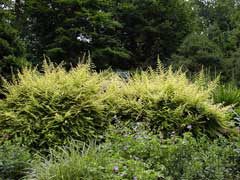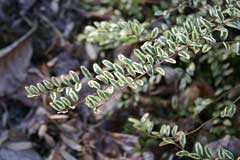 |
|
http://commons.wikimedia.org/wiki/User:SB_Johnny |
 |
| http://commons.wikimedia.org/wiki/User:SB_Johnny |
Translate this page:
Summary
Bloom Color: White. Main Bloom Time: Mid spring. Form: Spreading or horizontal, Upright or erect.
Physical Characteristics

 Lonicera nitida is an evergreen Shrub growing to 3 m (9ft) by 3 m (9ft) at a fast rate.
Lonicera nitida is an evergreen Shrub growing to 3 m (9ft) by 3 m (9ft) at a fast rate.
See above for USDA hardiness. It is hardy to UK zone 7 and is not frost tender. It is in leaf all year. The species is hermaphrodite (has both male and female organs) and is pollinated by Insects.
Suitable for: light (sandy), medium (loamy) and heavy (clay) soils and prefers well-drained soil. Suitable pH: mildly acid, neutral and basic (mildly alkaline) soils. It can grow in full shade (deep woodland) semi-shade (light woodland) or no shade. It prefers moist soil and can tolerate drought.
UK Hardiness Map
US Hardiness Map
Synonyms
Plant Habitats
Woodland Garden Dappled Shade; Shady Edge; not Deep Shade; Ground Cover; Hedge;
Edible Uses
References More on Edible Uses
Medicinal Uses
Plants For A Future can not take any responsibility for any adverse effects from the use of plants. Always seek advice from a professional before using a plant medicinally.
None known
References More on Medicinal Uses
The Bookshop: Edible Plant Books
Our Latest books on Perennial Plants For Food Forests and Permaculture Gardens in paperback or digital formats.

Edible Tropical Plants
Food Forest Plants for Hotter Conditions: 250+ Plants For Tropical Food Forests & Permaculture Gardens.
More

Edible Temperate Plants
Plants for Your Food Forest: 500 Plants for Temperate Food Forests & Permaculture Gardens.
More

More Books
PFAF have eight books available in paperback and digital formats. Browse the shop for more information.
Shop Now
Other Uses
Hedge Hedge
Can be grown as a medium sized hedge. It is very fast growing but needs lots of trimming[29, 200]. It is quite frequently used as a hedge plant in Britain[200]. The forms 'Graziosa' and 'Maigrün (Maygreen) can be used as ground cover plants[182, 197].
Special Uses
Ground cover Hedge Hedge
References More on Other Uses
Cultivation details
Landscape Uses:Border, Foundation, Hedge. A very easily grown and tolerant plant, it succeeds in any fertile soil, preferring a good moist soil in a sunny position[11, 200]. Succeeds in deep shade[202]. Established plants are fairly drought tolerant, so long as there is plenty of humus in the soil[190]. Plants are hardy to about -15°c[184, 202]. Another report says that it is not very hardy in northern Britain and that it rarely fruits in Britain[1]. Plants seem to be immune to the predations of deer[182]. A number of forms have been developed for their ornamental value[182]. Plants are very tolerant of pruning and can regrow from very old wood[202]. Plants in this genus are notably resistant to honey fungus[200]. Special Features:Not North American native.
References Carbon Farming Information and Carbon Sequestration Information
Temperature Converter
Type a value in the Celsius field to convert the value to Fahrenheit:
Fahrenheit:
The PFAF Bookshop
Plants For A Future have a number of books available in paperback and digital form. Book titles include Edible Plants, Edible Perennials, Edible Trees,Edible Shrubs, Woodland Gardening, and Temperate Food Forest Plants. Our new book is Food Forest Plants For Hotter Conditions (Tropical and Sub-Tropical).
Shop Now
Plant Propagation
Seed - best sown as soon as it is ripe in a cold frame. Stored seed requires 2 months cold stratification[113] and should be sown as soon as possible in a cold frame. When they are large enough to handle, prick the seedlings out into individual pots and grow them on in the greenhouse for at least their first winter. Plant them out into their permanent positions in late spring or early summer, after the last expected frosts. Cuttings of half-ripe wood, 7 - 10cm with or without a heel, July/August in a frame. Good percentage[78]. Cuttings of mature wood of the current season's growth, 15 - 20cm with or without a heel, November in a cold frame. Good percentage[78]. Layering in autumn[200].
Other Names
If available other names are mentioned here
Native Range
TEMPERATE ASIA: China (Gansu Sheng (south), Shaanxi Sheng (southwest), Sichuan Sheng, Yunnan Sheng)
Weed Potential
Right plant wrong place. We are currently updating this section.
Please note that a plant may be invasive in one area but may not in your area so it's worth checking.
Conservation Status
IUCN Red List of Threatened Plants Status :

Growth: S = slow M = medium F = fast. Soil: L = light (sandy) M = medium H = heavy (clay). pH: A = acid N = neutral B = basic (alkaline). Shade: F = full shade S = semi-shade N = no shade. Moisture: D = dry M = Moist We = wet Wa = water.
Now available:
Food Forest Plants for Mediterranean Conditions
350+ Perennial Plants For Mediterranean and Drier Food Forests and Permaculture Gardens.
[Paperback and eBook]
This is the third in Plants For A Future's series of plant guides for food forests tailored to
specific climate zones. Following volumes on temperate and tropical ecosystems, this book focuses
on species suited to Mediterranean conditions—regions with hot, dry summers and cool, wet winters,
often facing the added challenge of climate change.
Read More
Expert comment
Author
E.H.Wilson.
Botanical References
11200
Links / References
For a list of references used on this page please go here
Readers comment